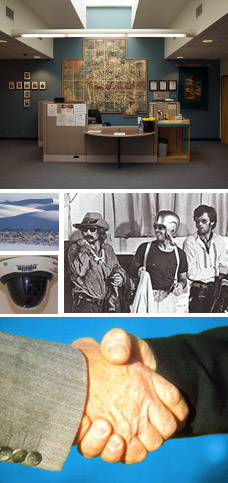
he Cumbres & T
oltec Scenic Railroad he
adquartered in Chama. It's easy to see why a large-scale production using so many different locations would locate its 100-plus crew in Chama for two weeks of filming, albeit during the 1988 Yellowstone fire when the smoke and haze drifted all the way d
own to the Cumbres Pass. Any one of the railroad's six steam-powered locomotives makes for an instant romantic screen presence, with the great power, beauty and determined grace that is touted by such engines. Then there's the terrain forming the backdrop – the 10,000-foot Cumbres Pass of alpine conifers and aspens, mountain streams and spreading meadows that gradually transform into open prairie land on the Colorado side of the tracks. This versatility, along with the magic of movie set dressing, has enabled production companies to shoot 1870s Westerns up to present-day stories meant to take place in Texas or Mexico or other parts of the country. "Indiana Jones and the Last Crusade remodeled the engine to look turn of the century rather than 1870s," said Earl Knoob, superintendent of operations for the C&TS RR. "They painted it to look like a locomotive that would've pulled a circus train of the era." Extensive modifications of some box car
s were also done for the project. Knoob recalls a scene where a rhinoceros horn comes through the roof, so the company carefully removed the tin and underlying boards and replaced them with painted balsa wood to do the shot. The original materials were then put back on. Another scene involved a boxcar that had a mechanical giraffe head operated with handlebars from below. "When they do stuff like that we have to make sure that what they're going to do is not going to adversely affect the historic integrity," Knoob said. The C&TS RR has national historic site status, which means that no structural changes or improvements to the depot can be made without approval from the State Historic Preservation Office. Some structural improvements are needed, according to Knoob, to accommodate the dramatic change in the scope of operations that the railroad has undergone - from 10 passengers a day in the early years up to 641 passengers at present. The railroad was built in 1880 by the Denver & Rio Grande Railway, to a gauge of 3
feet between the rails (so-called "narrow gauge"). The Rio Grande and successive companies operated the line as a freight and passenger railroad until 1968. At that time a grassroots effort was formed between the states of Colorado and New Mexico to preserve the railroad. This led to the creation of a bi-state authority that eventually drafted federal legislation to purchase the railroad. The
n in 1970, New Mexico and Colorado became joint owners of the 64 miles of track between Chama and Antonito, for a purchase price of about a half-million dollars. The bi-state commissi

